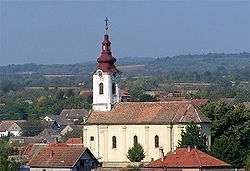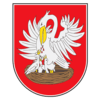Irig, Serbia
| Irig Ириг | ||
|---|---|---|
| Town and municipality | ||
 Serbian Orthodox church | ||
| ||
 Location of the municipality of Irig within Serbia | ||
| Coordinates: 45°06′N 19°51′E / 45.100°N 19.850°ECoordinates: 45°06′N 19°51′E / 45.100°N 19.850°E | ||
| Country |
| |
| Province | Vojvodina | |
| District | Srem | |
| Settlements | 12 | |
| Government | ||
| • Mayor | Radovan Ercegovac | |
| Area[1] | ||
| • Town | 55.10 km2 (21.27 sq mi) | |
| • Municipality | 230.07 km2 (88.83 sq mi) | |
| Elevation | 190 m (620 ft) | |
| Population (2011 census)[2] | ||
| • Town | 4,415 | |
| • Town density | 80/km2 (210/sq mi) | |
| • Municipality | 10,866 | |
| • Municipality density | 47/km2 (120/sq mi) | |
| Time zone | UTC+1 (CET) | |
| • Summer (DST) | UTC+2 (CEST) | |
| Postal code | 22406 | |
| Area code | +381(0)22 | |
| Car plates | RU | |
| Website |
www | |

Irig (Serbian Cyrillic: Ириг, pronounced [ǐriɡ]) is a town and municipality located in the Srem District of the autonomous province of Vojvodina, Serbia. The town has a population of 4,415, while Irig municipality has 10,866 inhabitants.
Name
In Serbian, the town is known as Irig (Ириг), in Croatian as Irig, in Hungarian as Ireg or Ürög, in German as Irick, in Slovak as Irig, and in Rusyn as Ириґ.
History
Irig was first mentioned in the historical documents in 1225. In the 15th century, the masters of the town were Serbian despots Vuk Grgurević, Đorđe Branković, and Jovan Branković. During the 15th and 16th century, ten Orthodox monasteries were built in the surrounding of Irig (Two of those were located just near the town).
Between 1526 and 1699, the town was under Ottoman administration. During this time, it belonged to the Sanjak of Syrmia, and was the administrative seat of one of the seven nahijas in that sanjak. In 1665, the town had 2,000 houses, one mosque and two monasteries. In this time, Irig was mostly inhabited by Muslim population.
Since 1699, Irig was part of the Habsburg Monarchy. In the 18th century, Irig was one of the most important market centers in Srem and most of its inhabitants were Serbs. In 1795-1796, the population of the town was decimated by plague. From the total population of 4,813 who lived in the town, 2,548 died of this disease.
In the late 19th and early 20th century, Irig was a district capital in the Syrmia County of the Kingdom of Croatia-Slavonia.
According to the 1900 census, the population of the Irig municipality numbered 22,313 inhabitants, of whom 16,893 were Orthodox Serbs, while the town of Irig itself had 5,196 inhabitants, of whom 3,936 were Orthodox Serbs.[3] According to the 1910 census, the population of the Irig municipality numbered 25,320 inhabitants, of whom 18,331 spoke Serbian, 3,552 Hungarian, 1,816 Croatian, and 1,031 German.[4]
Since 1918, Irig was part of the Kingdom of Serbs, Croats and Slovenes (later renamed to Kingdom of Yugoslavia) and subsequent South Slavic and Serb states. During World War II, 417 inhabitants of the town were executed by German fascists.
Characteristics
Located on the southern slopes of Fruška Gora, Irig has a specific microclimate which provides excellent conditions for viticulture.[5]
In the area surrounding Irig, there are 8 monasteries surviving today, built in the 15th and 16th century: Velika Remeta, Krušedol, Staro Hopovo, Mala Remeta, Novo Hopovo, Jazak, Grgeteg and Vrdnik.[5]
Serbian reading-room (Srpska čitaonica) is the oldest Serbian library in Vojvodina. It was founded in 1842 by Dimitrije Krestić, archimandrite of the Krušedol monastery. Originally it was located in three rooms of the local school (two were reading-rooms, one was library). Today it is situated in the Culture House, with 45,000 books, numerous painting, documents and photographs. The library contained first edition of works of Dositej Obradović, oldest editions of the Letopis Matice srpske, etc.
From the earliest days, both local and foreign newspapers (from Belgrade, Serbia, Pest, Croatia, Germany, etc.) could be read in it. During World War II, German soldiers and officers used the library as their quarters. Before their withdrawal, they blew up the building which then burned to the ground. The inhabitants rebuilt it themselves. Over 500 old books were donated by the citizens. The first theatrical shows in Irig were played in 1905.[5]
Inhabited places
Irig municipality includes the town of Irig and the following villages:
Demographics
| Historical population | ||
|---|---|---|
| Year | Pop. | ±% p.a. |
| 1948 | 13,839 | — |
| 1953 | 14,056 | +0.31% |
| 1961 | 14,709 | +0.57% |
| 1971 | 13,678 | −0.72% |
| 1981 | 12,413 | −0.97% |
| 1991 | 11,696 | −0.59% |
| 2002 | 12,329 | +0.48% |
| 2011 | 10,866 | −1.39% |
| Source: [6] | ||
According to the 2011 census results, the municipality of Irig has 10,866 inhabitants.
Ethnic groups
The total population of the Irig municipality is 10,866, which includes:[7]
- Serbs = 8,534 (78.54%)
- Hungarians = 762 (7.01%)
- Croats = 232 (2.14%)
- Roma = 166 (1.53%)
- Others and undeclared = 1,172 (10.79%)
Most of the local communities are ethnically Serb, while two have a Hungarian majority: Šatrinci (Hungarian: Satrinca) and Dobrodol (Hungarian: Dobradópuszta).
Twin cities
See also
References
- ↑ "Municipalities of Serbia, 2006". Statistical Office of Serbia. Retrieved 2010-11-28.
- ↑ "2011 Census of Population, Households and Dwellings in the Republic of Serbia: Comparative Overview of the Number of Population in 1948, 1953, 1961, 1971, 1981, 1991, 2002 and 2011, Data by settlements" (PDF). Statistical Office of Republic Of Serbia, Belgrade. 2014. ISBN 978-86-6161-109-4. Retrieved 2014-06-27.
- ↑ "Archived copy". Archived from the original on 2007-01-29. Retrieved 2007-01-02.
- ↑
- 1 2 3 Miroslav Stefanović (21 January 2018). "Zanimljiva Srbija: Irig - Neguju pisanu reč 175 godina" [Interesting Serbia: Irig - Tending for the written word for 175 years]. Politika-Magazin, No. 1060 (in Serbian). pp. 20–21.
- ↑ "2011 Census of Population, Households and Dwellings in the Republic of Serbia" (PDF). stat.gov.rs. Statistical Office of the Republic of Serbia. Archived from the original (PDF) on 14 July 2014. Retrieved 19 August 2017.
- ↑ "Population by ethnicity – Irig". Statistical Office of the Republic of Serbia (SORS). Retrieved 23 February 2013.
Other sources
- Dr Željko Vučković - Stevan Pištević, Povesnica Kulturno-umetničkog društva "Zmaj" u Irigu 1905-2005, Irig, 2005.
- Ladislav Varga, Mozaik žitelja iriških, Novi Sad, 2001.



